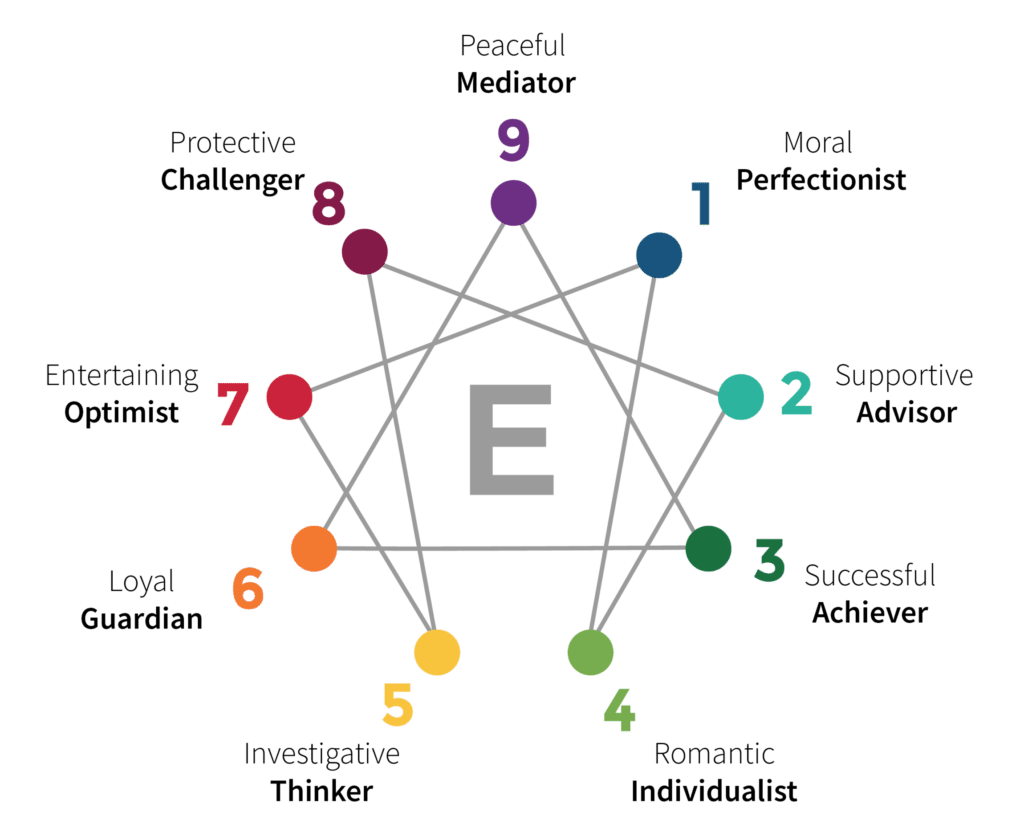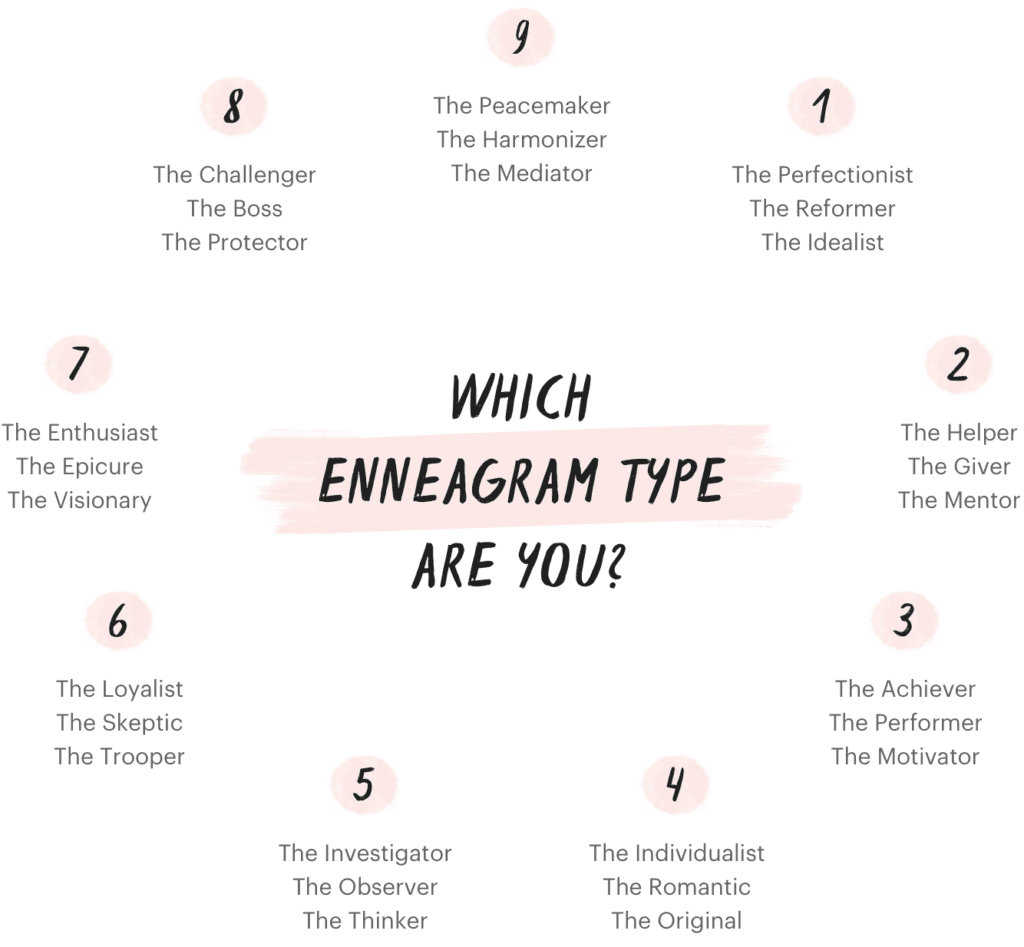You may have seen this funny-looking word “Enneagram” floating around your circle. I am the type that gravitates toward anything that explains {or attempts to} the inner workings of humans. I’ve nosedived into it all:: Myers-Briggs, Strengthfinder {now CliftonStrengths}, DiSC… But Enneagram is something just a smidge different.
The nine personality types outlined in the Enneagram system “describe patterns in how people interpret the world and manage their emotions.” Who doesn’t need a little more insight into that? Houston Moms writers are going to tackle each personality type in the coming months, identifying growth areas, strengths, and what they’ve learned about their type.
But first, let’s dive into a little background.
How the Enneagram Works

First and foremost, there are several different sites and “experts” around the subject. If you are brand new to Enneagram I suggest a quick tour around The Enneagram Institute for the most original {and grounded} information.
At its baseline Enneagram boils down to nine dominant personality categories that have taken on all kinds of colorful labeling. However, the originals are::
- Type 1:: The Reformer
- Type 2:: The Helper
- Type 3:: The Achiever
- Type 4:: The Individualist
- Type 5:: The Investigator
- Type 6:: The Loyalist
- Type 7:: The Enthusiast
- Type 8:: The Challenger
- Type 9:: The Peacemaker
Back it up for a minute. How did we get here? The Enneagram of Personality Types is a modern synthesis of several ancient wisdom traditions, but Oscar Ichazo originally put the system together. These ideas found their way from Greece and Asia Minor southward through Syria and eventually to Egypt. {Oh yeah, you can get deep with this.} But let’s fast forward slightly. Ichazo saw the Enneagram as a way of examining specifics about the structure of the human soul. This broke up into four categories:: Virtues, Passions, Holy Ideas, and Fixations.
Voilá! Modern-day Enneagram diagram. The premise is that everyone emerges from childhood {slightly scathed} with one of the nine types. You will dip your toe in a few pools, but your core self will rest pretty comfortably on one number of the dial.
Note:: Not everything you read about your type will apply to you 100% of the time because you fluctuate among the healthy, average, and unhealthy traits that make up your personality type {see Terminology}. Also, some things may absolutely apply to you even if you don’t want them to—sorry, Charlie.
All types are unique with assets and liabilities so stand proud behind your type—no one type is inherently better or worse. {Looking right at you, Threes.}
Terminology
Stay with me. You’re intrigued, but a little lost. Don’t fret, friend. This jargon will have you ‘graming like a pro.
The Centers – There are three centers: Instinctive Center, Feeling Center, and Thinking Center. Each Center consists of three personality types that have in common the assets and liabilities of that Center.
Wing – Everyone is a unique mixture of their basic type and usually one of the two types adjacent to it on the circumference of the Enneagram. One of the two types adjacent to your basic type is called your wing.
Levels of Development – The continuum is comprised of nine internal Levels of Development—briefly, there are three Levels in the healthy section, three Levels in the average section, and three Levels in the unhealthy section.
Integration (Growth) & Disintegration (Stress) – There are two lines connected to each type, and they connect with two other types. One line connects with a type that represents how a person of the first type behaves when they are moving toward health and growth and the other line represents how the person is likely to act out if they are under increased stress and pressure.
Math Quiz:: Stress for each type is indicated by the sequence of numbers {1-4-2-8-5-7-1; 9-6-3-9}. Meaning that when a One is under stress, they act out like a Four. Growth is a reverse sequence, the opposite of their unhealthy direction {1-7-5-8-2-4-1; 9-3-6-9}. So a Seven during Integration would reflect influences of a healthy Five.
Label Me!
I know, just give you your type already! There are all kinds of labels associated with Enneagram. They will tell you which books you should read and what color palette you gravitate toward {some are more accurate than others}. But you can’t play the game if you don’t have the pieces.
One recommended way to truly discover your type is to research all of the types and reflect on the strengths and growth areas to help determine where you land. {Swell, but who has time for that?} There are several resources online that will help you find your type {some more time-intensive than others}, but sources say the paid version is well worth the investment.
CAUTION:: “Misidentification” {basically insisting you are the wrong type} is not altogether uncommon. Enneagram is complex—so are humans. As you explore your type and take your test, try to avoid overthinking “always” and “never” scenarios. Consider your most common and innate reaction. Although Nines have principal traits of serenity and peacefulness, it doesn’t mean that they never get angry.
*Houston Moms does not endorse nor guarantee the accuracy of any Enneagram test.
Give Me More

I’m with ya, sister. You are now hooked and need more information—stat! Luckily, there are several resources available to guide you down the Enneagram rabbit hole. And just for giggles, do yourself a favor and follow Leeann & Michelle for some seriously hilarious {and painfully accurate} typecasting.
- The Road Back to You
- The Path Between Us
- The Modern Enneagram
- Millenneagram
- The Enneagram for Beginners
- The Honest Enneagram
- The Enneagram Made Easy
- Enneagram Test: The Ultimate Guide
- The Essential Enneagram
Stay tuned! This Enneagram journey is just beginning. For the next nine months, our Houston Moms writers will be giving you first-hand accounts of life behind their Enneagram type.
Disclaimer: We are a participant in the Amazon Services LLC Associates and other Affiliate Programs designed to provide a means for us to earn fees by linking to Amazon.com, Target.com, Nordstrom, ABC Mouse, and other affiliate sites.














Hi Kirsten,
lovely introduction. I would like to suggest another resource, too, to find out and learn+grow with your personality type, fears, and motivations!
I tried a couple of different sites and experts, but found https://personalitypath.com/ to be the simplest, most rounded resource out there (they’re also endorsed by the late Andreas Ebert, one of the top-experts and pioneers of the Enneagram.
In terms of helping you discover yourself and learn to live and grow with it, it’s my go-to place 🙂